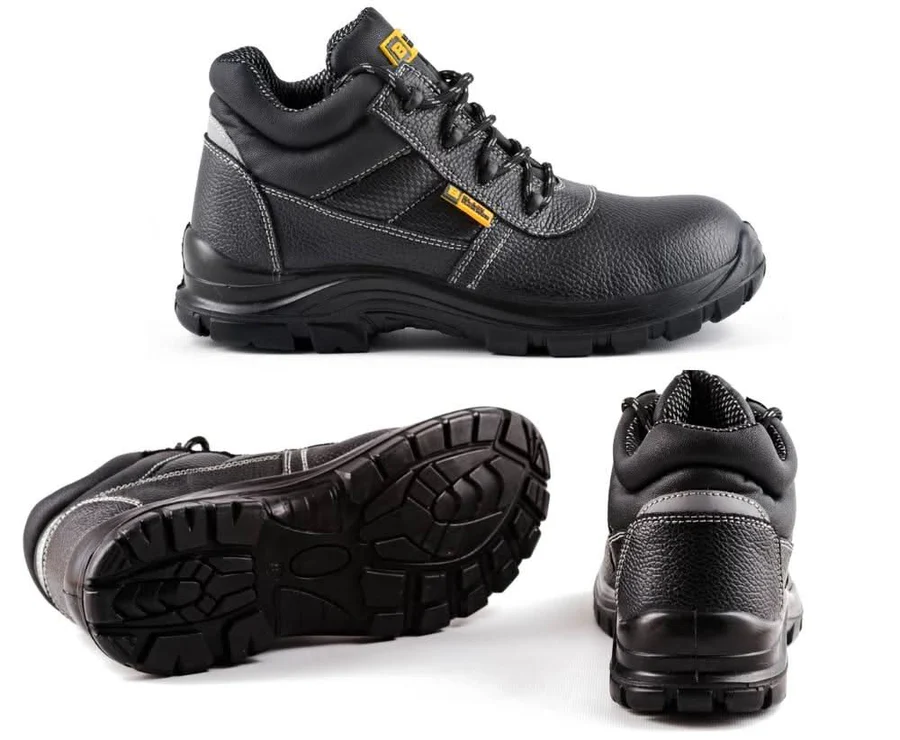Safety boots are more than just work footwear—they’re essential equipment that protects your feet from injuries, heavy loads, and harsh environments. At Black Hammer, we understand the importance of keeping your boots in top condition. Well-maintained boots not only protect your feet but also last longer, ensuring comfort and reliability throughout the workday.
This guide will show you step-by-step routines for cleaning, maintaining, and protecting your safety boots, including advice for different materials, seasonal care, minor repairs, and hygiene practices. Following these steps ensures your boots remain safe, durable, and comfortable for years to come.
Clean Your Boots Regularly
Cleaning your boots frequently prevents dirt, mud, and chemicals from damaging materials and compromising waterproofing.
Daily Cleaning
- Brush off loose dirt: Use a soft-bristled brush to remove debris from seams, eyelets, and soles.
- Wipe down surfaces: A damp cloth works for leather and synthetic materials. Avoid soaking the boots.
- Check laces and eyelets: Replace any frayed laces or damaged eyelets.
Weekly Cleaning
- Leather boots: Apply a leather cleaner or saddle soap, then condition to prevent drying.
- Suede and nubuck: Brush the nap with a suede brush and spot-clean stains using a suede-specific cleaner. Avoid water.
- Synthetic boots: Wipe with mild soap and water, rinse, and air-dry.
Pro Tip: If your boots are exposed to oil, grease, or chemicals, clean them immediately after use to prevent long-term damage.
Dry Your Boots Properly
Moisture is one of the most common causes of damage. Incorrect drying can lead to cracked leather, odours, and weakened adhesives.
- Air-dry naturally: Remove insoles and allow boots to dry at room temperature.
- Avoid direct heat: Radiators, fireplaces, or sunlight can cause leather to dry out and crack.
- Use newspaper or boot trees: These help absorb moisture and maintain shape.
- Rotate boots: If you have multiple pairs, rotate them to allow each pair to dry completely between uses.
Extra Tip: For extremely wet boots, remove the laces and loosen eyelets to allow better airflow inside the boot.
Apply Waterproofing and Protection
Waterproofing keeps your boots functional in wet conditions, prevents damage, and enhances comfort.
- Leather boots: Use a water-repellent spray or wax. Reapply after cleaning or exposure to rain, snow, or slush.
- Suede and nubuck: Apply a specialised suede protector spray. Avoid oils that can darken the material.
- Synthetic boots: Use sprays suitable for synthetic materials.
Pro Tip: Reapply waterproofing at least once a month, or more often if your boots are regularly exposed to water or chemicals. Maintaining waterproofing ensures boots perform in wet conditions and extend their life. For best results, check out our safety boot waterproofing and care products designed for heavy-duty use.
Care for Different Materials
Boot care differs depending on material. Here’s how to maintain each type:
Leather Boots
- Clean with leather cleaner or saddle soap.
- Condition regularly to maintain flexibility and prevent cracks.
- Polish to restore shine and appearance.
Suede and Nubuck
- Brush with a suede brush to lift dirt and restore texture.
- Spot-clean stains with a specialised cleaner.
- Apply suede protector spray to maintain water resistance.
Synthetic Boots
- Wipe with mild soap and water.
- Avoid harsh chemicals that can weaken the material.
- Inspect seams, soles, and protective features regularly.
Composite and Steel-Toe Boots
- Follow material-specific cleaning instructions.
- Inspect toe protection for dents or cracks after impacts.
- Ensure the safety features remain intact for workplace compliance.
Seasonal Boot Care
Environmental factors like rain, snow, or sun exposure can impact your boots. Seasonal care ensures longevity and comfort.
Winter
- Waterproof thoroughly before snow or slush exposure.
- Remove wet boots immediately to prevent frost damage.
- Use boot dryers, newspaper, or boot trees to absorb moisture.
Summer
- Protect leather from prolonged sun exposure to prevent drying and cracking.
- Clean sweat and dirt regularly.
- Rotate boots to allow drying and reduce odours.
Pro Tip: Store boots in a cool, dry place away from direct sunlight during seasonal changes.
Inspect and Repair Minor Damage
Minor damage can quickly escalate if ignored. Regular inspections prevent expensive replacements.
- Scuffs and scratches: Buff leather with a soft cloth and leather polish.
- Loose stitching: Reinforce with strong thread or a boot repair kit.
- Worn soles: Replace insoles or consider professional resoling if the manufacturer allows.
- Damaged laces or eyelets: Replace to maintain safety and fit.
Tip: Always inspect boots after heavy work days to catch issues early. Small issues like scuffs or worn soles can escalate if ignored. That’s why many workers rely on our durable safety boots collection built to last, even under tough site conditions.
Maintain Insoles and Laces
Comfort and hygiene depend on the condition of insoles and laces.
- Insoles: Remove and wash weekly. Replace if worn to maintain support.
- Laces: Replace frayed or stretched laces to ensure proper fit and safety.
- Odour control: Use baking soda, boot deodorisers, or moisture-absorbing insoles to keep boots fresh.
Avoid Common Mistakes
Many workers unintentionally damage their boots. Avoid these mistakes:
- Machine washing boots
- Using harsh household cleaners
- Applying direct heat to dry quickly
- Ignoring minor scuffs or loose stitching
- Skipping waterproofing after cleaning
Tools and Accessories for Boot Maintenance
Using the right tools makes boot care easier and more effective:
- Soft-bristled brushes for leather and dirt removal
- Stiff brushes for soles and treads
- Leather cleaner, conditioner, and polish
- Suede/nubuck cleaning kits
- Waterproof sprays for each material
- Boot deodorisers and moisture-absorbing products
- Newspaper or boot trees for drying
Safety and Hygiene Considerations
- Boot care isn’t just cosmetic, it safeguards your feet and maintains workplace safety.
- Damaged stitching can compromise boot structure and protective features.
- Wet or odorous boots can cause blisters, fungal infections, or reduced insulation.
Regular maintenance ensures your boots remain safe, comfortable, and compliant with workplace standards.
Daily, Weekly, and Deep-Clean Schedule Table
|
Routine |
Leather |
Suede/Nubuck |
Synthetic/Composite |
|
Daily |
Brush & wipe |
Brush & wipe |
Wipe with damp cloth |
|
Weekly |
Clean & condition |
Brush & protector |
Clean & inspect |
|
Monthly/Deep Clean |
Deep clean, polish, condition |
Spot clean, protect |
Deep clean, inspect |
|
Seasonal |
Waterproof & inspect |
Protector & dry |
Clean thoroughly & inspect |
Conclusion
Maintaining your safety boots is essential for protection, comfort, and durability. By following these rules and regularly cleaning properly drying, waterproofing, making minor repairs, material-specific care, and seasonal routines—you can ensure your boots last longer and continue to protect your feet effectively. Trust Black Hammer for the tools, products, and advice to keep your safety boots in top condition.
Need help maintaining your safety boots? Contact us today for expert advice and recommendations tailored to your needs.

